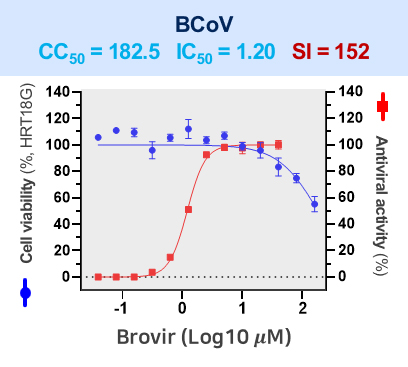Brovir
Antiviral Brovir
- Currently, Brovir is being developed intensively by Pharmacolinx Inc.
- Brovir is a small molecule drug candidate that can treat various RNA virus infections, including prototype and mutant COVID-19 strains and influenza A virus.
- The mechanism of action of Brovir is as follows.
- Various free radicals, such as the host's reactive oxygen species produced to suppress the replicaiton of RNA viruses, also damage the host cell membrane. As a result, after the mid-stage of infection, extracellular nutrients cannot move into the cells, and the cells fall into a state of nutritional deficiency. This nutritional deficiency in cells prevents progeny viral production. In preparation for intracellular nutritional deficiency, viruses store lipid droplets (LDs) in the cytoplasm from the early stage of infection, and from the mid-stage of infection onwards, the fatty acids produced by dissolving lipid droplets (LDs) with lipolytic enzymes, such as inhibiting triacylglyceride-targeting adipose triglyceride lipase (ATGL), diacylglyceride-targeting hormone-sensitive lipase (HSL), and monoacylglycerol-targeting monoacylglycerol lipase (MAG), are used to propagate the virus.
- Brovir suppresses viral proliferation by inhibiting the ATGL.

Antiviral Brovir-continued
- Brovir was developed based on novel mechanisms of action.
- The green nutrients seen in the figure below move into the cells until the mid-phase of viral infection.
- However, after the mid-phase of infection, cell membranes are damaged.
- As a result, nutrients cannot move into the cells, so green nutrients cannot be observed within the cells.
- In other words, after the mid-phase of infection, cells become nutrient deficient, and the virus cannot proliferate.
Developed Based on a Novel Mechanism of Action!


- Viral cell infection
- Cell membrane damage at the middle stage of infection
- Interruption of intracellular movement of extracellular nutrients
- Intracellular nutrient deficiency
- Blockage of viral replication
- Accordingly, the virus also had a plan in case of a nutritional deficiency.
- Viruses let lipid droplets (as seen green in color) accumulate from early to mid-phase viral infection.
- During the mid-phase of infection, lipid droplets are dissolved by the lipolytic enzymes shown yellow in color in the figure below.
- The various fatty acids produced at this time are used to propagate the virus.
Even Viruses Had a Plan for Nutritional Deficiencies!
-
Viruses!
-
Preparation for nutritional deficiencies, LIPID DROPLETS!
-
Digestion of lipid droplets by host lipolytic enzymes
-
Produced FFAs are usedfor viral replication!

- Virus infection
- Saving lipid droplets in the cells

- Host lipolytic enzymes
- Lipolysis of LDs from the middle stage of infection
- Accordingly, our company's Brovir inhibits ATGL, a lipolytic enzyme, and ultimately blocks fatty acid production, preventing the virus from multiplying.
Mechanism of Brovir Action
-
Brovir!
Inhibition of lipolytic enzyme! -
Blockage of FFA production from LDs!
-
Inhibition of viral replication!

- Brovir
- Inhibition of viral morphogenesis

- Brovir
- Blockade of energy production
- Brovir
- Inhibition of viral replication
- Brovir showed excellent antiviral efficacy in animal tests.
- As shown below, when mice are inoculated with the influenza virus, they all die within 10 days. When administered 5 mg of brovir, 63% survived.
- Additionally, when 80 mg of brovir was administered to hamsters after challenge with the COVID-19 virus, pneumonia lesions were reduced by 72%.
- In conclusion, Brovir showed excellent efficacy in animal tests.
Excellent Efficacy Even in Animal Tests!

- 5 mg/kg Brovir
- 63% survival

- 80 mg/kg Brovir
- 72% reduction in pneumonia
- Brovir safely inhibited the proliferation of various viruses, including SARS-CoV-2 and influenza, as shown below, at very low concentrations.
- This means that Brovir showed broad-spectrum antiviral efficacy.
Broad-Spectrum Antiviral Effects on Various Viral Infections!
- COVID-19 and pandemic influenza cause a cytokine storm in the lungs, causing severe pneumonia.
- Eventually, cytokine storm worsens severity and mortality.
Another Problem with COVID-19 and Pandemic Influenza!
-
COVID-19 & Influenza
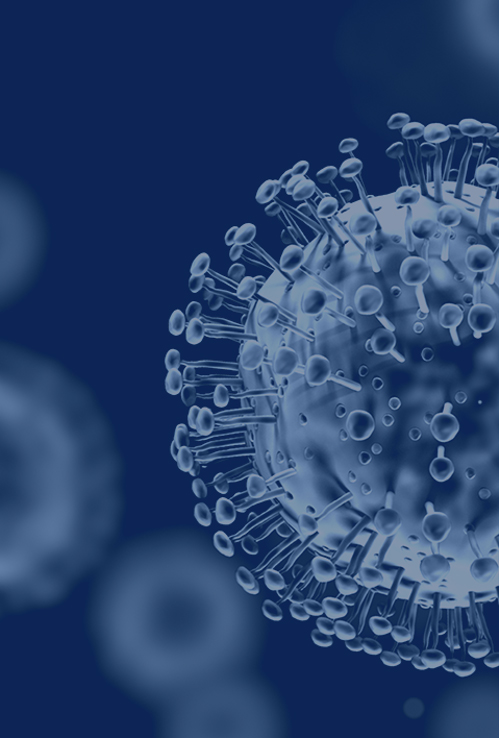
-
Causing cytokine storm in the lungs

-
Severe serouse pneumonia

-
Death from respiratory failure, as if drowning
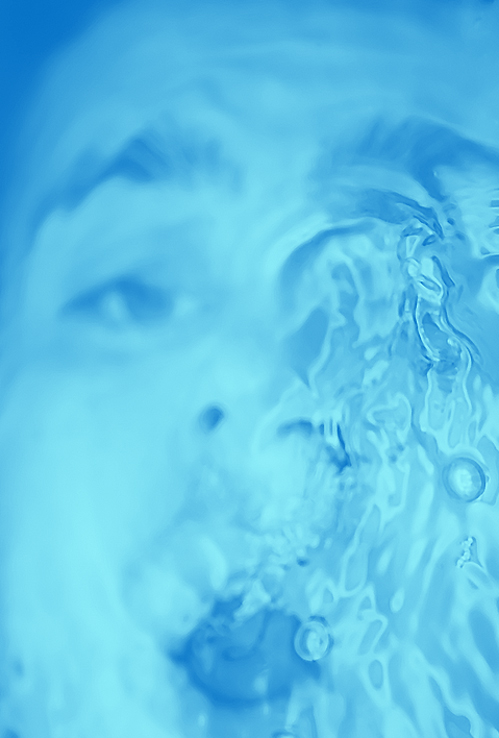
- Brovir suppressed the cytokine storm in cells and animals infected with influenza and COVID-19 viruses.
Suppressing the Cytokine Storm!
- Vehicle
- Brovir
- CAY 10499
-
IFN-α (in vitro)

-
IFN-β (in vitro)

-
IL-6 (in vitro)

-
TNF-α (in vitro)

-
MCP-1 (in vitro)

-
Cells infected w/ IAV or COVID-19 virus
-
Treatment w/ Brovir
-
Reduction in cytokine storm
-
IFN-α (lung tissue)

-
IFN-β (lung tissue)

-
IL-6 (lung tissue)

-
TNF-α (lung tissue)

-
MCP-1 (lung tissue)

-
Animals challenged w/ IAV or COVID-19 virus
-
Administration w/ Brovir
-
Reduction in cytokine storm
- The therapeutic effect of Brovir can be clearly seen by viewing lung lesions under a microscope. The first tissue panel you see below is a normal lung with many holes.
- However, in the lungs infected with the COVID-19 virus, the empty holes are barely visible.
- When brovir is administered in increasing concentrations, the number of empty pores increases.
- When 80 mg is administered, it becomes almost normal.
Curing Pneumonia by Suppressing Cytokine Storm!
-
Negative control
-
Virus-challenged, vehicle-treated
-
Brovir 20 mg kg-1 d-1
-
Brovir 40 mg kg-1 d-1
-
Brovir 80 mg kg-1 d-1
-
H&E





-
IHC

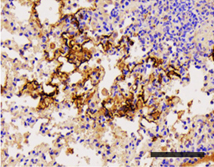
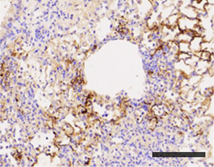


- The mechanism of action of Brovir can be summarized as follows.
The Importance of Lipids & Lipid Droplets (LDs) in Virus Replication

Baek YB, et al. 2022. Therapeutic strategy targeting host lipolysis limits infection by SARS-CoV-2 and influenza A virus. Signal Transduct. Target. Ther. 7(1):367. IF = 39.3. Corresponding author
-
[Host Defense Mechanism]
Infection of viruses ▷ Production of ROS & RNS ▷ Gradual cell membrane damage ▷ After middle stage of infection ▷ Loss of cell membrane function ▷ Impaired influx of nutrients into cells ▷ Intracellular nutrient deficiency ⇒ Impairment of Viral Replication
-
[Evasion Mechanism of Viruses]
Accumulation of LDs from the beginning of infection ▷ After middle stage of infection ▷ Intracellular nutrient deficiency ▷ Activation of lipases (ATGL, HSL & MGL) ▷ Lysis of LDs ▷ Production of free fatty acids (FFAs)
-
[Usage of FFAs by Viruses]
① Viral replication compartments, ② Viral morphogenesis, ③ Energy sources, ④ Eicosanoid & cytokine storms ⇒ Determinants for Virus Replication & Pathogenicity
Conclusion : Inhibitors of host cellular lipolytic enzymes ⇒ Host-Directed Broad-Spectrum Antiviral Drugs



